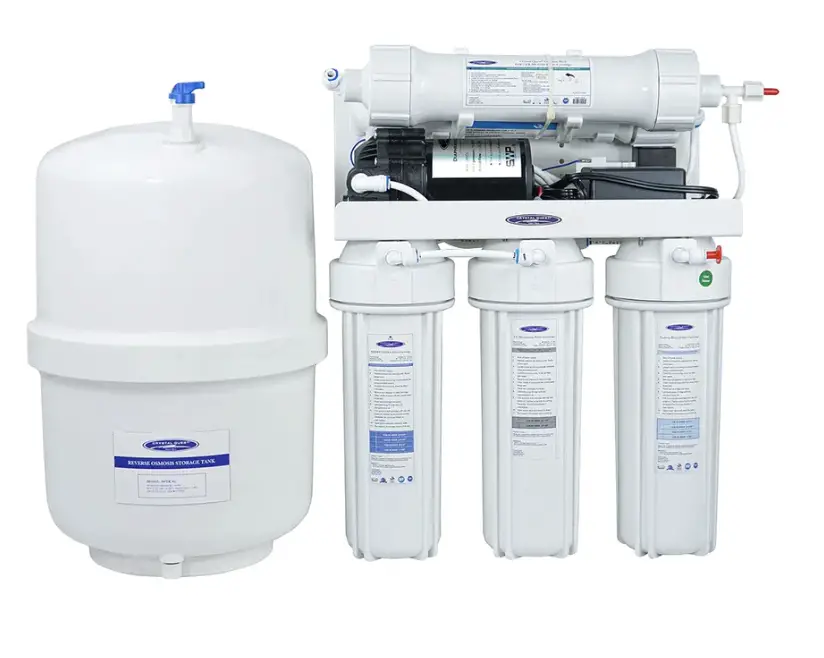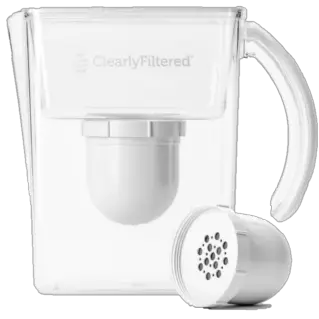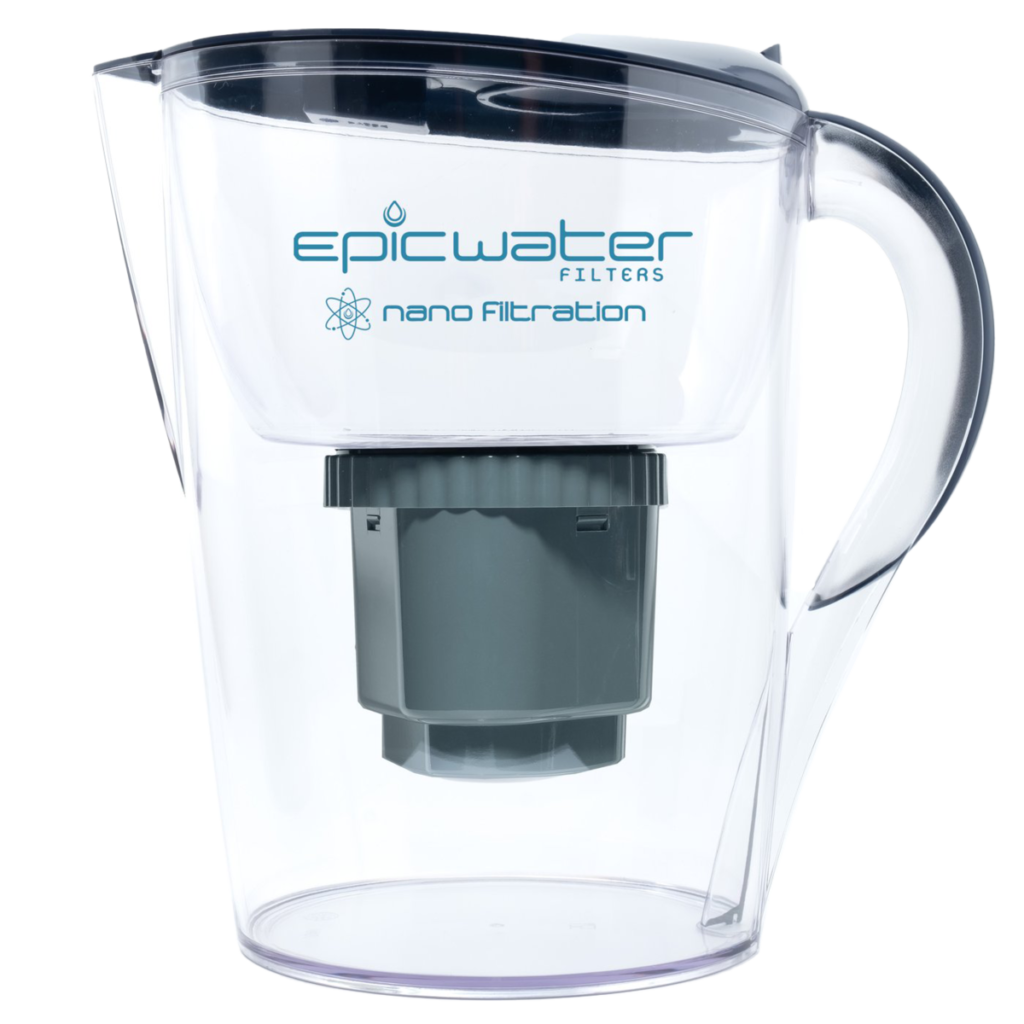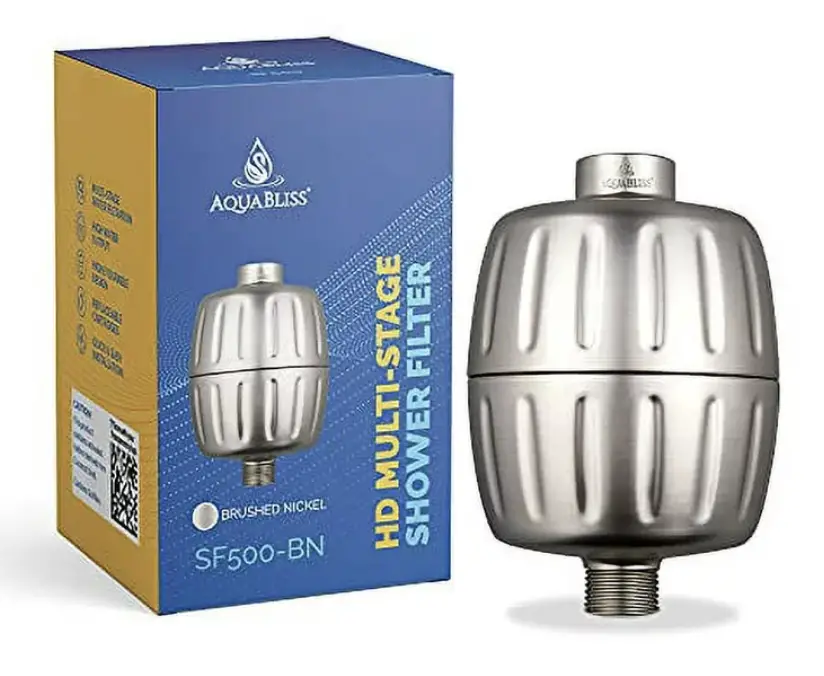Glyphosate is one of the most used herbicides in the U.S., to this day more than 1.8 million tons of it are used each year.
Reverse osmosis systems, distillation units and water filter pitchers with granular activated carbon or nano filters can effectively remove glyphosate from water. Pitchers or filter bottles with powdered activated carbon filters and carbon blocks are ineffective.
This article explains what glyphosate really is and how to remove it, plus the types of water filters that are the best for removing it.
Glyphosate In Our Water
Glyphosate was discovered in the USA in the 1970s, and because of its powerful ability to kill plants, it took no time to become famous as an all-round herbicide.
As of 1974, the use of glyphosate as the active ingredient in Roundup saw its use exponentially increase. In fact, Glyphosate is one of the most effective herbicides that is used to kill broad-leafed grasses and other weeds. It’s even effective at controlling aquatic weeds.
You can find Glyphosate in more than 750 gardening and lawn maintenance products.
How It Enters Our Drinking Water
Unfortunately, our lakes and rivers, which is where most of our tap water comes from, can easily become contaminated by glyphosate through the following processes:
1. Spray Drift
Herbicide or pesticide spray drift is the movement of pesticide droplets or dust through the air during or shortly after application (“spraying’).
Spray drift can carry glyphosate molecules in the air to lakes, rivers and dams.
2. Rainwater Run Off
When rainwater falls, it rinses the soil and removes the glyphosate. The glyphosate then mixes with the rain and flows overland until it reaches a river or lake, and contaminates them.
Farmers can help control the flow of the Glyphosate-carrying topsoil using techniques like vegetative buffer, to stop it from entering our drinking water.
3. Direct Application to Reduce Aquatic Weeds
Aquatic weed control using glyphosate-based products is regarded as safe. However, any glyphosate-based aquatic herbicides must be mixed with a surfactant which makes it safe for aquatic life and acceptable for use in water. If the amount of glyphosate compared to other ingredients is slightly wrong, it can leach directly into our water, polluting the supply.
How to Remove Glyphosate from Drinking Water
Glyphosate can be removed from water by reverse osmosis, nanofiltration, distillation and to a certain degree, activated carbon.
1. Reverse Osmosis
Reverse osmosis is one of the most effective methods of purifying drinking water. A reverse osmosis filter usually consists of 3 to 6 stages of filtration.
The main stages that are found in almost all RO systems include:
A Sediment Filter that removes large particles like dirt and debris from drinking water (this has no effect on glyphosate)
An Activated Carbon Filter that traps tiny particles, including chlorine and some glyphosate.
A Semi-Permeable Membrane, which has incredibly tiny holes (as small as 0.001 microns) and can capture most contaminants, including glyphosate.
A reverse osmosis system can remove more than 92% glyphosate from water. The combination of the activated carbon filter and membrane makes this the most effective method for removing glyphosate. The membrane removes more than 90% of the glyphosate, while the granular activated carbon filter also removes a small amount.
Any reverse osmosis system can remove glyphosate as they all have a ‘membrane’, but those that have a granular activated carbon filter will be able to remove more than those with a carbon block or powdered activated carbon filter. Like this one:

The 1000CP Thunder Reverse Osmosis System from Crystal Quest uses 12 stages of filtration.
It includes the membrane and a granular activated carbon filter, which are the best ways to remove glyphosate from water.
If you’re also concerned about Atrazine in your water, you can read more about how to remove it here.
2. Water Filter Pitchers
Water filter pitchers that have either granular activated carbon filters or nanofilters can remove glyphosate from water. Filter pitchers, like Brita, with carbon blocks, powdered activated carbon filters or ion exchange resins cannot remove glyphosate.
So make sure you check what type of filter it has before you buy one.
A recent study demonstrated that granular activated carbon filters can remove more than 98.45% of the glyphosate in water. The glyphosate is adsorbed onto the surface of the carbon. Coconut shell GAC has so far shown to be the most effective of the different activated carbon filter types.
A water filter pitcher with granular activated carbon filter is the most affordable way to remove glyphosate from water, for example:

The Clearly Filtered water filter pitcher comes with a 3-stage filtration system that can remove more than 365 water contaminants, including Glyphosate.
In fact, this pitcher has been tested and can remove >99.9% of glyphosate from water.
Water filter pitchers that use nanofiltration (NF) can remove glyphosate. Like reverse osmosis, nanofiltration uses membrane technology, and is efficient enough to remove up to 94.5% glyphosate and other pesticides from drinking water. There aren’t many filter pitchers available that use nanofiltration, but this is one of them:

The Epic Nano water filter pitcher comes with a powerful filter that’s able to remove more than 99.9% of the glyphosate found in water.
In fact, water filter pitchers aren’t the only way to remove glyphosate on the go – water bottle filters that use the same types of filters can also remove it. For example Clearly filtered’s insulated stainless steel water bottle can remove more than 220 contaminants, including the 99.7% glyphosate
3. Distillation
Drinking water can also be purified via distillation. The concept of distillation producing clean water is inspired by the natural mechanisms of evaporation from lakes and rivers, and condensations from clouds.
In the distillation process:
- Water is heated at a high temperature till the evaporation process starts. Vapors rise and leave all the impurities down.
- In the second stage, vapors enter the coolant pump, where condensation begins.
- In the final stage, condensed water is collected in a container.
Research conducted by the Nebraska Water Center has demonstrated distillation can remove 99.9% of Glyphosate from drinking water.
Distillation counter-top units are easily available, and all have the same ability to remove glyphosate.
4. Shower Filters
Shower Filters often have Kinetic Degradation Fluxion (KDF) or vitamin C along with stainless steel mesh, and none of these filtration materials are known to remove Glyphosate from water.
However, a few shower filters use activated carbon and can remove pesticides from water, including:

The AquaBliss Heavy Duty Shower Filter SF500, which uses calcium sulfite, granular activated carbon and redox media to reduce contaminants from both hot and cold water.
The granular activated carbon component should be able to remove some glyphosate from water.
It’s activated coconut shell carbon is very effective in removing a wide range of pollutants from shower water quickly and easily. But it’s not known how much glyphosate it can remove. This is because the water only comes into contact with the filter for a short amount of time – compared to a filter pitcher for example.
The longer water is in contact with a filter, the more contaminants can be removed.
5. Chlorination (oxidation)
Chlorination is a traditional method of water disinfection that the government uses to purify our tap water. While the chlorine is mainly added to the water supply to kill germs it also removes glyphosate through oxidation.
Generally, the community supplied water is treated via chlorination by adding chlorine or chloramine. A small amount (4mg/L) of chlorine or chloramine to chlorinate the water is safe for human health
Oxidation by chlorine can effectively remove glyphosate from your water supply.
So while this is an effective way to remove glyphosate, it isn’t something we can do in our own home.
The Long Term Problem With Glyphosate
Research shows that glyphosate can remain in water for 2 to 12 weeks. Glyphosate decays over time to aminomethylphosphonic acid (AMPA), which microbes can successfully degrade and isn’t considered harmful (unlike glyphosate).
Glyphosate takes between 3 days and 19 weeks for half of the active ingredient to degrade to AMPA.
But in the time it takes to degrade, we can be exposed to contaminated water.
It’s important to note that glyphosate is unlikely to enter groundwater because it tightly binds to the soil particles when applied to the crops. The strong bonding of glyphosate with soil particles limits its mobility preventing it from seeping into ground water.
Soil microbes also readily degrade glyphosate – although, this process is limited in low oxygen conditions.
Examples of Glyphosate Contamination in the USA
Detection of Glyphosate in Minnesota Waters
The Minnesota Department of Agriculture (MDA) routinely tests the presence of glyphosate in surface and groundwater. It is typically found in surface waters of both urban and rural areas at low concentrations. The highest levels of glyphosate were detected in surface water in 2016, when it reached 42.8 micrograms per liter (µg/L). No glyphosate was detected in the groundwater.
USGS Survey
U.S. Geological Survey (USGS) researchers examined 51 streams in nine Midwestern States to look for the presence of a variety of herbicide including glyphosate, in 2000. About 154 water samples were taken across nine Midwestern State and the results demonstrated that 36% of the samples contained glyphosate, while 69% samples contained its degradation product AMPA.
Effects of Glyphosate on Human Health
According to the Environmental Protection Agency (EPA), Glyphosate’s maximum contaminant level (MCL) is 700ug/L (or micrograms per liter). However, the suggested MCL demands more research with many suggesting it needs to be lowered.
According to the National Pesticide Information Center, swallowing products containing Glyphosate can cause:
- Nausea
- Diarrhea
- Vomiting
- Increased saliva
- Burns in the throat and mouth
- Reproductive issues
- Leaky-gut syndrome
- Endocrine disruption
- Celiac disease
- Effect on erythrocytes
Carcinogenic Herbicide
Glyphosate is considered so hazardous that the International Agency for Research on Cancer regards it as “probably carcinogenic.”
Another study reports that exposure to Glyphosate-based herbicides can increase the risk of non-Hodgkin lymphoma by 40 percent in the human body.
Glyphosate Build Up
According to Agency for Toxic Substances and Disease Registry (ASTDR), Glyphosate doesn’t accumulate in the body significantly. However, it can be easily absorbed through the respiratory or gastrointestinal tract. Skin can absorb only minute quantities of Glyphosate.
References:
1. Bexfield, L.M., Belitz, K., Lindsey, B.D., Toccalino, P.L. and Nowell, L.H., 2020. Pesticides and pesticide degradates in groundwater used for public supply across the United States: occurrence and human-health context. Environmental Science & Technology, 55(1), pp.362-372.
2. Peillex, C. and Pelletier, M., 2020. The impact and toxicity of glyphosate and glyphosate-based herbicides on health and immunity. Journal of Immunotoxicology, 17(1), pp.163-174.
3. Yuan, J., Duan, J., Saint, C.P. and Mulcahy, D., 2018. Removal of glyphosate and aminomethylphosphonic acid from synthetic water by nanofiltration. Environmental technology, 39(11), pp.1384-1392.

